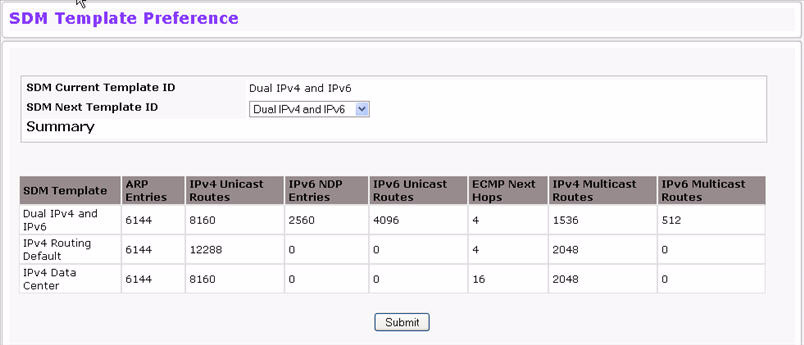A Switch Database Management (SDM) template is a description of the maximum resources a switch or router can use for various features. Different SDM templates allow different combinations of scaling factors, enabling different allocations of resources depending on how the device is used. In other words, SDM templates enable you to reallocate system resources to support a different mix of features based on your network requirements.
NOTE: If you attach a unit to a stack and its template does not match the stack's template, then the new unit will automatically reboot using the template used by other stack members. To avoid the automatic reboot, you may first set the template to the template used by existing members of the stack. Then power off the new unit, attach it to the stack, and power it on.
To display the SDM Template Preference page, click System > SDM Template Preference in the navigation menu.

SDM Template Preference
Field |
Description |
|---|---|
SDM Current Template ID |
Displays the SDM Template that is currently active. |
SDM Next Template ID |
Select the template that will become active after the next reboot:
|
SDM Template (Summary) |
Identifies the available templates. |
ARP Entries |
The maximum number of entries in the IPv4 Address Resolution Protocol (ARP) cache for routing interfaces. |
IPv4 Unicast Routes |
The maximum number of IPv4 unicast forwarding table entries. |
IPv6 NDP Entries |
The maximum number of IPv6 Neighbor Discovery Protocol (NDP) cache entries. |
IPv6 Unicast Routes |
The maximum number of IPv6 unicast forwarding table entries. |
ECMP Next Hops |
The maximum number of next hops that can be installed in the IPv4 and IPv6 unicast forwarding tables. |
IPv4 Multicast Routes |
The maximum number of IPv4 multicast forwarding table entries. |
IPv6 Multicast Routes |
The maximum number of IPv6 multicast forwarding table entries. |
Click Refresh to display the latest information from the router.